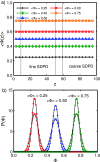Multiscale simulation of ideal mixtures using smoothed dissipative particle dynamics
- PMID: 26931689
- PMCID: PMC5942450
- DOI: 10.1063/1.4942499
Multiscale simulation of ideal mixtures using smoothed dissipative particle dynamics
Abstract
Smoothed dissipative particle dynamics (SDPD) [P. Español and M. Revenga, Phys. Rev. E 67, 026705 (2003)] is a thermodynamically consistent particle-based continuum hydrodynamics solver that features scale-dependent thermal fluctuations. We obtain a new formulation of this stochastic method for ideal two-component mixtures through a discretization of the advection-diffusion equation with thermal noise in the concentration field. The resulting multicomponent approach is consistent with the interpretation of the SDPD particles as moving volumes of fluid and reproduces the correct fluctuations and diffusion dynamics. Subsequently, we provide a general multiscale multicomponent SDPD framework for simulations of molecularly miscible systems spanning length scales from nanometers to the non-fluctuating continuum limit. This approach reproduces appropriate equilibrium properties and is validated with simulation of simple one-dimensional diffusion across multiple length scales.
Figures





References
-
- Moreno N., Vignal P., Li J., and Calo V. M., Procedia Comput. Sci. 18, 2565 (2013).10.1016/j.procs.2013.05.442 - DOI
Publication types
MeSH terms
Grants and funding
LinkOut - more resources
Full Text Sources
Other Literature Sources

